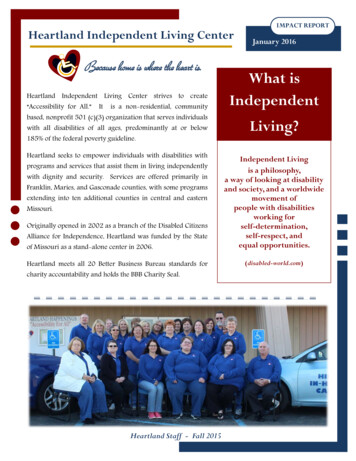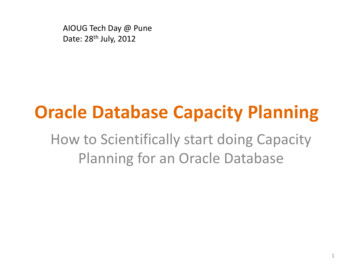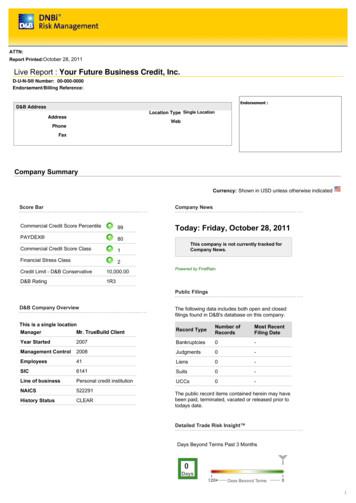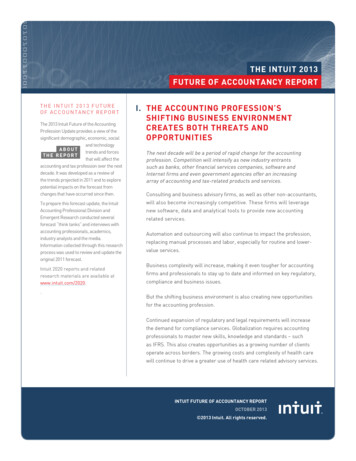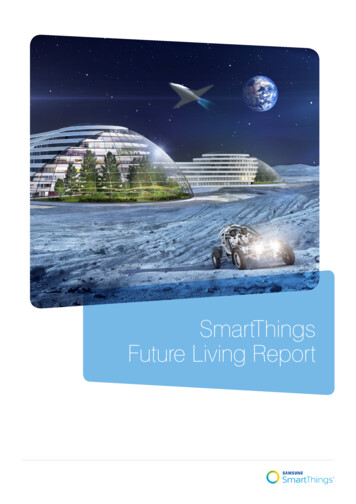
Transcription
SmartThingsFuture Living Report
SmartThingsFuture Living eable, adjustable, personalised home/work environments(Even Smarter) SmartThingsVirtual Decoration3D printed furniture and homewareSustainabilityGrow your own at homeSelf-cleaning/repairing materialsArchitecture of the FutureAquatic HomesBuilding up/digging downWork, Science and ResearchIntegrated Artificial Intelligence (AI)The working weekMedicine and AgeingHomes equipped with medical screening equipmentMedicine and ProcreationLeisureCommercial space flight a realityDrone delivered holiday homes3D printed food and leisure materialsVirtual leisureAnd finally.Living in space. Colonies established first on Mars, and thenon nearby habitable planetsThe Authors
ForewordSince the dawn of time, we humans have strived to enhance ourliving and working environments. The environments we live in todayare almost unrecognizable from those that existed just a centuryago. The Internet is a great example of this. As this technologyhas spilled over from laptops to smartphones, we’ve become usedto having total knowledge and control in the palm of our hand.The smartphone revolution is now ushering in the smart homerevolution, making it possible for anyone to easily monitor, control,and secure their home from anywhere through one simple app.This wave of technology is already here, and it’s having a massiveimpact on how we secure our homes, stay connected to lovedones, and save energy. The lights, locks, appliances, and everydayobjects in our homes are waking up. As we continue to breatheintelligence into these ordinary objects, our homes are becomingsmarter and can detect the presence of things like people, pets,smoke, humidity, lighting, and moisture. They’re beginning tobecome intuitive and sense our habits, automatically responding toour personal needs and preferences. And this is just the beginning.Just as the technology driving the Internet has spread tosmartphones and smart homes, the smart home revolution isdestined to wash over us and spill into larger communities andcountries. As more and more homes and cities wake up anddevelop a sixth sense, it will have massively positive implicationson how we live.By simply turning this off when we don’t use them, we can reduceemissions by up to 30%. If enough homes become greener, we canattain widespread energy conservation and create a greenerplanet. By being able to better monitor and secure our homes,we can reduce the overall crime rate in cities. By better monitoringthe habits of ageing relatives, we help seniors achieve greaterindependence and a higher quality of life.James Monighan,UK MD Samsung SmartThings
IntroductionDr Maggie Aderin-Pocock MBE, is an acclaimed space scientist,managing director at Science Innovation Ltd and co-presenter ofthe long running, popular astronomy program ‘The Sky at Night’.Award-winning architects and Westminster University lecturersArthur Mamou-Mani and Toby Burgess have spent five yearsexploring the concept of future living; everything from autonomouscommunities to new materials and digital fabrication tools. LindaAitken and Els Leclercq are professional urbanists who establishedtheir own practice, studioAitken, in 2003 and who embedsociological and urban design solutions to rapidly evolving andincreasingly complex urban issues. Alongside Dr Aderin-Pocockand Samsung SmartThings, they have joined together to conductresearch into the future of living.OverviewTechnology and engineering areevolving at a faster rate than at anyother time in history. The world todayis unrecognisable from 100 yearsago, and not just in an aestheticcapacity, but in the way that we, ashumans, function within it. Advancesin these fields have redefined the wayin which we live our lives, how wecommunicate and interact.We all remember the beginnings of theinternet. From noisy modems to ICQchats, AOL, Netscape and Compuserve– we were able to access dynamicpages from our computers; makinginformation interactive and instantlyaccessible to people around the world.Then Google, Facebook, Samsung andthe likes organised this immensity ofdata, gave us better access to it –and in doing so, connected us to itsbillions of users.Now, over a quarter of a century later,we are faced with a new game-changer–known as The Internet of Things – andlike the internet before it, its evolution isset to reach a phenomenal speed. Firstdeveloped through DIY initiatives suchas Arduino and Pachube, it is alreadybeing developed by companies suchas Samsung with its recently acquiredbusiness: SmartThings. Expandingupon the principals of the internet,this technology is just the beginningin a movement that will see furtherinterconnectivity between the digitaland physical worlds, as in the firstinstance, we become able to controlphysical elements of our lives via oursmart phone devices. Motion sensors,Presence sensors, Moisture sensors,Locks, Electrical outlets, Speakers,Thermostats are now controllable viathe SmartThings app and this list isonly expanding.Twenty-five years ago, this wouldhave seemed like a pipe dream,inconceivable even – much like theinternet before it. But both are here;the future is now. The internet allowedall of us to connect as a singlecollective brain – this global andinter-connected intelligence can nowencompass the material world,opening up endless possibilities.So given the advances already inmotion now, what can we expect tosee in 100 years’ time? How will we live;how will we work; how will we relax?With so much more scope for whatcan be achieved than ever before;is the sky the limit?
AccommodationMalleable, adjustable,personalised home/work environmentsAccording to the World UrbanisationProspects 20141 issued by the UnitedNations, the urban population in 2014accounted for 54% of the total globalpopulation, up from 34% in 1960, andwill continue to grow (approximately1.84% per year between 2015 and2020; 1.63% per year between 2020and 2025; and 1.44% per yearbetween 2025 and 2030).Just as the last 100 years have witnesseda seismic shift in the way we live, theway we interact with our living space willalso change beyond all recognition.As living space in cities becomesscarce, our buildings and interiorswill evolve into hyper-flexible spaces.(Even Smarter)SmartThingsWith the development of technologylike Samsung SmartThings (whichalready allows objects within thehome to be interconnected onlineand controlled via a simple appor automated through everydayroutines), progress to incorporatethese wearable devices that are ableto give remote control over a widerarray of things, the fundamentalway in which we utilise our homeswill shift. Imagine being able to justsearch online to find lost items withinthe home without having to scour theentire building for hours.Houses will be controlled through a newgeneration of software that will learnRooms will serve different functions,walls, floors, ceilings will haveembedded technology which will allowthem to change position depending onthe activity (i.e. making the bedroommuch smaller and living room largerwhen receiving guests)2.These smart walls will be able to changetheir own shape in 3D by using smallresponsive actuators pushing andpulling a flexible skin - creatingtemporary seats or shelves. All thishardware will be connected to wearabledevices to which we will add and managethe components of our homes in asimilar way to how we currently buyand use apps.from our living patterns and suggestthe appropriate wall configuration,furnitures or add-ons that will then beimplemented or 3D printed. Actuators,connected to sensors, as well as homeapps, will also have the intelligence toadapt to body shape - informing of anyposture issues and correcting themthrough bespoke exercises.Even the buildings themselves willbe capable of adapting to the needsof its inhabitants and the externalenvironment. Based on sensors anduser-interfaces, terraces will openup when drones arrive or when solarradiations are too high3 and will retractagain when the interiors are too cold.1World Urbanization Prospects - The 2014 Revision View2As researched by the Changing Space studio of Kent Larson at MIT Media Lab View3For Origami Facades See the Al Bahar tower in Abu Dhabi
AccommodationVirtual DecorationAdvances in augmented reality andprojection mapping will mean thatpeople’s homes will function as thebackdrop for projections, seen onlyby the inhabitant 4 . As a result of this,walls will be plain and unadornedto the outside observer but seen asanything desired by the user.Anything from ornate 3D sculptures,to baroque dreamscapes and ruralpastures will be downloadable, sothrough wearable technologies twopeople sharing the same room mayexperience totally different spaces.For a more communal experience,projection and LED wall surfaces willbecome commonplace, with home3D printed furnitureand homeware4Through technology likeSamsung Gear VR and Oculus Rift5ETH Zurich University’s Institute for3D printing, which is already a reality,will take off in a big way. We will be ableto purchase and download designs,and then customise them to fit ourexact requirements in terms of shape,size and colour. We will each havesmall capacity 3D printers in our homesenabling us to print smaller items,whilst for larger items, we will take ourpurchased designs to a local 3D printshop where they will be generated toour particular specifications.This will lead to a reduction intransportation and delivery costs, asonly raw materials will be shipped tohomes and 3D shops, allowing for thelocal production of the desired item.3D printing will not just be confined tosingle items, in fact, in recent years ithas been developed to construct homesin a fraction of the time of conventionalbuilding practices, as well as utilisingrecycled materials. With homes andparts of the home being available todownload and print as the user wishes(even fabrics), anyone will be able to livein a designer home.Dynamic Systems and Control andGramazio Kohler Research6Printed homes ViewNew ref. polymer dissolving saltsViewFurniture will be 3D printed, makingit possible to upload houses onto a‘Domestic Facebook’ in which peoplewill proudly share their homes like theyinteriors reading and then adaptingto the inhabitants’ mood. Embeddedwithin the interior wall furnishings,a multitude of tiny interconnectedLEDs will be programmable viawireless computer technology.These will alter in appearance to analmost infinite number of responses- from mirroring traditional wallpaperdesigns, to displaying (including inreal time), scenes from placesthroughout the world.A new ubiquitous information age offree and unlimited data will open uppossibilities of continuously connectedstreaming infographics displayed on allthe walls internally and externally.currently share their pictures. Peoplewill visit or reprint people’s homesthrough Virtual Reality headsets or 3DPrinters of their own. Landlords will beable to print bespoke virtual interiorsbefore his or her tenants move in.Not only that, but it will be possible togenerate homes using algorithms thatwill take into account social patterns,search engine usage, structural forces,site-specificity, latest innovations andsponsorship. These algorithmic homes willthen be printed by swarms of 3D printingdrones also controlled by the algorithm.5In terms of recycling, new developmentsin solvents will be able to breakdownthe polymers that make up these 3Dprinted items into it monomer blocks.These will then be reconstituted tomake new items for the home, againlimiting transportation costs and tying into the recycling culture of the time. Theultimate in recycling.63D printing has already allowed forcomponents within the aerospace industryto be manufactured in a tenth of the timetraditional components can be, and madeand using less than a fifth of the material –and this technology can work using novelmaterials such as titanium.
AccommodationSustainabilityAs non-renewable resources reduce,sustainability will be at the heart ofour lifestyle choices.Recycling will be fully integrated inour own homes and our wastes willcreate fuel and electricity througha process called Microbial fuel cellstacks7. This will be applied to foodand plastic wastes as well as toiletsand wastewater. A bio-electrochemicalsystem within the home will mimicbacterial interactions found in nature.This ‘digestion tank’ will produce bothgas and clean water in a process calledanaerobic digestion. Power will bestored in each home through efficientlithium-ion batteries8, taking everyoneoff the grid and removing the needfor large power-plants, thus reducingnuclear waste and carbon emissions.Energy will also be harvested via thenatural environment. Smart solarpanels, wind turbines and piezo platesGrow your ownat homePeople will grow theirown food indoors,using hydroponics andaquaponics farms.9 10Sustainability will not just beapparent in energy productionand usage, but also within foodproduction. As education aboutdiet increases, it will becomecommonplace for people to growtheir own food at home.Hydroponics is the process of growingplants without soil, only using nutrients;aquaponics combines this process,using an aquarium, to create the plantnutrients from fish waste. Having sucha closed-loop system in kitchens willprovide fresh fruit as well as fresh fishwill be integrated in the building fabricand connected to the individual’s smartapps. The software and sensors willhighlight the wattage being stored inreal-time and warn about wasted power.As communication is transmitted in anincreasingly wireless manner, so too isthe likelihood that alternative forms ofelectricity and/or its transmission willemerge. This could include capturingthe energy generated from particle/atomic movement and collisions. Fusionwill become less of a lab experimentand more commonplace as we utiliseEinstein’s equation E mc2 to generatecopious amounts of energy cheaply,cleanly and
Then Google, Facebook, Samsung and the likes organised this immensity of data, gave us better access to it – and in doing so, connected us to its billions of users. Now, over a quarter of a century later, we are faced with a new game-changer –known as The Internet of Things – and like the internet



